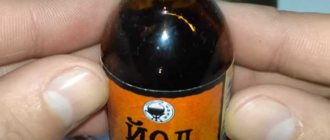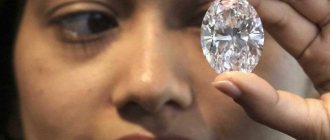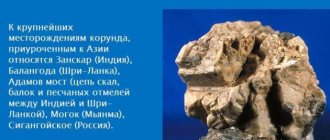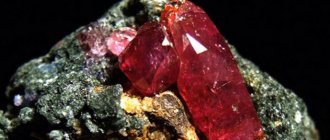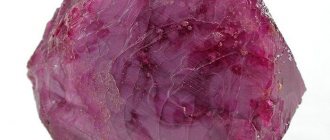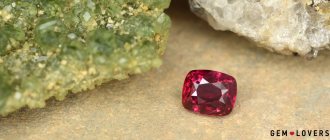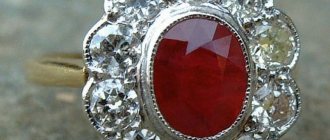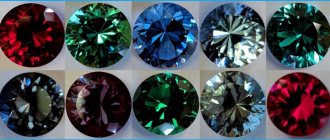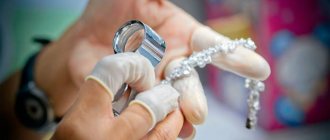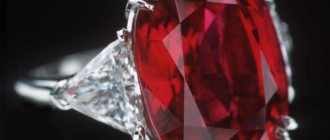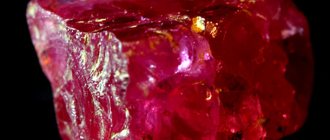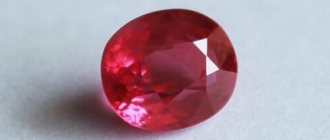The beauty and value of a refined ruby can only be rivaled by polished diamonds. In fact, it is a crystalline variety of corundum - a mineral of igneous origin and consisting of aluminum oxide with small impurities of iron and chromium.
Its special feature is its extraordinary hardness, second only to diamond. In nature, large ruby stones are extremely rare, so they sometimes cost more than a carat even more than diamonds.
Ruby deposits
Mining such stones is not an easy task. In addition to this, there are several places on the planet where red crystals can be found at great depths.
In Myanmar (formerly Burma), the highest quality and most expensive rubies are mined. The stones from this deposit are also called “pigeon blood”, since in addition to their blood-red color they have a purple tint. Pigeon blood is also found in Vietnam.
The town of Mong Shu, located in India, also boasts unique rubies, mostly black with red edges. In terms of cost, they are often even more expensive than “pigeon’s blood”, since they are extremely rare. Almost the entire population of the town works in crystal mining.
All deposits differ in their shade. The third largest deposit is located in Ceylon. Coral-colored rubies, unique in their beauty in Russia, are mined there. Although they are not in high demand like blood red ones, their price is also high.
However, recent studies have shown that even in these deposits there are very few crystals left. Soon the last stone will be extracted from the depths, which may indicate a further increase in the price of the unique mineral.
Magic properties
Ruby is a sign of love and passion, eternal feelings and sincerity. It makes the owner better, smoothing out the negative aspects of character, but can increase the cruelty and harshness of the owner. Good yachts protect from the evil eye, envy, slander and hypocrisy.
Scarlet corundum is a love amulet. It ignites and supports the tender feelings of a couple.
When worn constantly, the jewelry:
- promotes enlightenment;
- helps to develop;
- brings peace of mind;
- prolongs life;
- helps to win;
- protects against natural disasters;
- lures money;
- develops the entrepreneurial qualities of the owner;
- awakens clairvoyance abilities.
The stone belongs to the fire element and is associated with the power of the Sun and Mars.
Dragon Blood Clot
Ruby in religions
The mystical stone is important to followers of most religious teachings.
Scarlet corundum:
- Hindus have a way to influence the creation of a crowd;
- for rabbis it symbolizes disasters and wars;
- among the Chaldeans it is associated with the happiness of motherhood;
- helps Buddhists achieve their goals.
Customs associated with stone
Previously, it was believed that the gem showed whether food was poisoned. To do this, a ring decorated with jewels was immersed in it. To check whether the blade of the sword was poisoned, they brought a stone to it with an insert.
Ruby is associated with tender feelings. To awaken love and passion in the chosen one, they presented her with a decoration with a scarlet yacht.
Corundum shows poison
Characteristics of real crystals
The characteristics of real rubies are quite rare among other minerals, so an experienced jeweler can accurately identify a fake by the following points:
- crystal hardness. As mentioned above, ruby is second only to diamond in its hardness, which places it in the first class of hardness, and on the Mohs scale it has 9 units. Having such high hardness, the stone is extremely difficult to break, leave a crack or even a scratch;
- cut. Thanks to its hardness, it is easy for jewelers to work with, and it costs an experienced craftsman nothing to make clear, defined edges;
- color As mentioned above, both pink, coral, and red-burgundy rubies are found in nature. It is also common to come across stones with a gradient;
- shine. Compared to igneous origin, only rubies have a strong glossy shine, giving off red highlights when illuminated.
Medicinal properties
Ruby is a healing stone valued in lithotherapy and official medicine. Doctors use it:
- for dental prosthetics;
- during dental implantation;
- for the production of lasers for ophthalmic operations.
Healers recommend red yacht for:
- paralysis;
- melancholy;
- epilepsy;
- sexual weakness;
- problems in the gastrointestinal tract.
Lithotherapists resort to stone when fighting:
- asthma;
- high blood pressure;
- joint and vertebral diseases;
- ENT diseases;
- sleep disorders.
Scarlet yakhont - a healing mineral
The mystical stone helps when constantly worn in jewelry and drinking water infused with it. The healing power of the liquid depends on the size of the sample applied by the lithotherapist. The synthetic specimen does not have healing qualities.
Unofficial medicine recommends the gem for ulcerative, skin, heart, and vascular diseases. It improves metabolism, relieves fever, activates the immune system and tissue regeneration, and stabilizes the nervous system. The scarlet variety improves hearing and improves blood health. Dark fruit is good for memory, treats scabies and activates appetite. Light pink is recommended for stress and fatigue.
Types of samples
To avoid buying a fake, it is important to know what rubies are found in nature. There are not so many of them, the main and most common are:
- Burmese ruby. Everything mined in Myama has a certificate. The price for them is always very high. The crystals are deep red in color and very bright.
- Pigeon blood. Stones mined in Myanmar must also have a certificate. They are distinguished by a very dark color, often giving off a purple tint. It is almost impossible to counterfeit “pigeon blood” due to some technical aspects of the process.
- Star crystals. They are the rarest and most expensive. The name speaks for itself. Inside the crystal, the glow has a star shape. And just like “pigeon blood”, it is impossible to fake starlight today.
Where is it used?
The main area of application of scarlet yacht is jewelry.
Synthetic specimens are popular in costume jewelry and are used in watch mechanisms and industry.
Jewelry
Rubies cut – faceted:
- stepped;
- diamond.
Cabochons are made from opaque samples. The most valuable are transparent natural crystals formed naturally.
Other areas
Low-quality rubies are in demand in industry. The elements are made from them:
- hours;
- bearings;
- lasers.
Synthetic specimens are laser components.
Dragon's blood is used by jewelers and industrialists
Methods for synthesizing artificial crystals
In the mid-twentieth century, rubies grown synthetically began to appear on the jewelry market. Synthetic stones are visually almost no different from their analogues. Obtained by growing a single crystal from corundum.
Modern technologies make it possible to “grow” rubies with properties close to the original. Synthetic stones have ideal transparency, large size and almost complete absence of cracks. But an experienced jeweler can easily distinguish a stone of natural origin from a synthetic one.
Today, artificial rubies are produced using four methods:
- Czochralski;
- Vernel;
- flux;
- hydrothermal.
The most advanced methods are Czochralski and Vernel. By the way, the French scientist Vernel was the first who managed to grow synthetic ruby. Using these methods you can obtain the largest and cheapest stones. Minerals grown using these methods are distinguished by their curved growth lines.
Flux and hydrothermal methods are very expensive, but with their help it is possible to grow the most perfect rubies. Often, even experienced jewelers can hardly tell by eye what is a natural stone and what is synthetic. Therefore, when purchasing a large specimen, just in case, it is better to consult an experienced gemologist.
Areas of use
Most natural and synthetic gems are used for industrial purposes. The durability of the stone makes it useful in many industries, including watchmaking, astronomy, optics and electronics. For example, the material is used to create sandpaper, lasers and bearings for precision mechanisms.
For jewelry processing, only materials that belong to category 1 are used. Preference is given to stones mined from well-known deposits. Raw rubies of lower quality are often purchased by collectors.
How to distinguish a real ruby from an artificial one
After filling the jewelry market with imitation natural stones, the issue of recognizing a fake has become extremely acute. Today there are many ways to distinguish a real ruby from a fake:
- The easiest way to check the authenticity of a stone is to put it in a glass glass; even a regular faceted one will do. The glow should be reflected from the glass. Synthetic stone does not have such properties.
- If exposed to an ultraviolet lamp, the original will appear red. Synthetics will still glow orange.
- Presence of bubble inclusions. Synthetic stones have one feature. As a result of the ongoing physical and chemical manipulations, tiny inclusions remain on the surface, formed from bubbles of gas released during the reaction.
- Chromium content. Natural stones with a pigeon's blood hue have a very delicate balance of chromium content, which is the root cause of the hue. It is not possible to achieve such a fine balance, and at the same time the shade, in synthetic crystals. Therefore, if a ruby has a “pigeon’s blood” tint, then it is one hundred percent original.
- If it has a crack, then you need to pay attention to its shape. In natural stones it will always be zigzag. This is due to the high hardness of the crystals, which synthetics do not fully possess. She almost always has them straight.
- Weight. A real ruby, since it is a hard and heavy mineral, will always be heavier than it appears visually.
Method 1: Valuing ruby at home
Of course, no one can evaluate a stone better than an experienced jeweler. However, in cases where there is no opportunity to contact a specialist, but you really want to know, there are simple methods for identifying a ruby at home. These manipulations can easily be carried out at home.
The simplest thing you can do is view the stone in natural light. By pointing the crystal towards the sun, the side facing the luminary will play and shimmer, while the opposite side will remain dull.
The second method requires stone and glass. Due to their exceptional hardness, red stones can easily cut glass and thin-walled metal. If a red mark remains in a scratch on glass or metal, this is a sign that, most likely, the stone is not of natural origin.
Naturally occurring crystals are poor thermal conductors. If you take a stone, some recommend placing it on your eyelid and holding it for a short amount of time, it should not heat up quickly. If the stone becomes warm within a couple of minutes, most likely it is synthetic or colored corundum or a completely different stone.
Another effective way is to place the stone in a container of water. A real stone should have a red shimmer in the water.
You should not buy jewelry that does not provide for inspection from the inside. This is an old trick of unscrupulous jewelers, and it is better to refuse such a purchase immediately.
Although this method is dubious, it is worth mentioning. It is believed that if you leave a stone in a glass of homemade cow's milk, the milk will soon turn pink. In this case, the stone is considered to be real. But this method should not be trusted.
Method 2: Consult a jeweler
Why should you turn to specialists? Because even if a stone passes all home tests perfectly, this does not mean that it is worth its price. The stone can simply be reconstructed. Reconstructed natural stones are real fragments fused together.
The master's assessment is a guarantee of authenticity. And if you send the stone for examination to the Assay Office, an organization that guarantees the sale of genuine and high-quality stones in the country, then there is no doubt about the authenticity.
Method 3. Examining the stone with a magnifying glass
For this study, a 10x magnifying glass or microscope is better suited.
What you should pay attention to during inspection:
- edges and cutting. They should be clear and even. If the edges are rounded, the stone is most likely fake;
- shine the stone under a magnifying glass. Examining the glow under a magnifying glass, deep tints and gloss should be easily noticeable. If the stone is star-shaped, then the overflows should have a star shape. It is worth remembering that the non-transparent side should remain cloudy or matte;
- if fragments are examined, then straight, even layers should be visible in the cross-section. In fake stones they are completely chaotic or crooked.
History and origin
Historians believe that ruby is a stone known to mankind since the Bronze Age. It was during this era that the first developments began in Burma. 2,000 years ago, Hindus used the red gem as a talisman. The Tamils, who lived in ancient times in southeast Asia, knew about the incredible hardness of rare opaque stones of a grayish tint. They called them corundums.
Later, the breed was appreciated by the Greeks and Romans. In the Middle Ages, it symbolized the life-giving Fire and the protection of the daylight. The modern name for the gemstone comes from the Latin language: “rubens” means blushing.
Legendary Scarlet Jewel
In 1835, a method for producing a synthetic type of stone was invented.
In 1960, the world's first laser was developed. Its important structural part is the ruby.
Legends about the mineral
Already in ancient times, people noticed the properties of ruby - the magic stone attracted attention with its hardness and rarity. Myths were made about him; the oldest that have come down to us are dated to the 4th century AD. The most famous legend says: the red gem is dragon eyes.
In the Middle Ages, people believed that in the dark a ruby glowed like a hot coal. This is how the magical aura reflects and demonstrates the astral power of the mineral.
Roman myths associated the jewel with the warlike god Ares and the titan Kronos. Through the breed they controlled the passions of man.
Among the Japanese, Chinese, Indians and Burmese, scarlet corundum symbolized imperial greatness. It represented passion, vitality and happiness. In India he was called the king, the leader of the precious stones. Hindu legends told about the southern sun - the source of the divine juice of life from which the mineral comes, and the mystical river Ravanaganga. At its bottom, in the reflection of palm trees, rested beautiful stones that lit up in the darkness with an internal fairy-tale fire that filled the space around with golden rays.
The mineral has great mystical significance for followers of Islam. It is believed that it laid out the 4th Heaven, ruled by Israfil. This Heaven was created from the heart of the Almighty - true and absolute love.
Valuable mineral has been known since ancient times
Christian myths associate ruby with other minerals, believing that it combines their properties. In ancient treatises it is described as the most valuable of the 12 stones created by the Almighty. The red yacht around Aaron's neck symbolized his primacy as a priest; 3 copies represent the passions of the Lord, and 5 – the wounds he received during the crucifixion.
The legends about the gem are reflected in the name of the Rubin football club.
How to distinguish a ruby from other stones
They often try to pass off other, cheaper ones as him. Often these are pyrope, red tourmaline and spinel.
They try to pass off only red stones as an ennobled ruby, since an experienced person will not confuse other shades of the crystal with anything else.
Ruby can be easily distinguished from pyrope by its color. The reds are more of a purple hue, and the pyrope has a red wine hue. If you still have doubts from comparing the color, it is worth checking for magnetization. Pyrope is magnetic, ruby is not.
Counterfeit tourmaline is also easy to check. Tourmaline does not withstand ultraviolet testing. Light passing through a stone turns orange, and through a ruby it turns red.
But with spinel everything is more complicated. Although it has a strawberry color, there are rubies with a similar shade, so it is impossible to say for sure whether it is spinel. Such a stone should be sent to a jewelry laboratory for examination.
Coloring
Injecting colored dyes into pores or cracks in gemstones to change their color. Cracks were sometimes deliberately induced by heating the stone so that the non-porous material would more easily absorb paint.
The most common colored gemstones are:
Pearl. Dye can often improve the color of cultured pearls.
Many pearls that go on sale are colored.
Other precious materials. This method has been used since ancient times for materials such as coral, turquoise, lapis lazuli, howlite, jade, chalcedony, quartz, emerald and ruby.
Natural chalcedony (colorless sphere on the left) can be dyed in a variety of colors. A piece of chalcedony (right) can be painted in a variety of colors. This sample was further cut into sections to produce material of different colors.
The coral on the left was originally bleached and then dyed.
Durability Factor
When a dye is applied to porous materials, this hardening can increase their durability, but it ultimately depends on the stability of the dye itself. Dye can sometimes leak into large cracks in stones in various ways. Many dyes can be removed with solvents such as alcohol or acetone. Some dyes are not resistant to ultraviolet radiation from the sun and the color may gradually fade.
Detection
In most cases, a qualified gemologist can detect colored gemstones.
In trade
Occurs occasionally on most gemstones and often on colored pearls.
Care requirements
If gemstones are known to have been dyed, care must be taken to avoid exposing them to chemicals such as acetone or alcohol, which can dissolve dyes, and to avoid prolonged exposure to sunlight (for example, leaving it on a sunny windowsill), otherwise In this case, the color of the stone may disappear.
Radioactive treatment
Currently, this type of refining of jewelry stones is very common. There are several processing methods, each of which has a specific purpose. Sometimes radiation treatment is used in combination with heat.
Radiation treatment is commonly used on the following stones:
aquamarine - combined with heat treatment to improve the blue color;
diamond - to improve color (from off-white to “fancy” color), to saturate yellow and orange shades. Neutron and electron radiation are the most common forms of artificial irradiation. It produces black, green, blue-green, dark yellow, orange, pink and red diamonds. Radiation is often combined with heat. Bright colors in green, pink and red diamonds should almost always be considered suspicious when grading.
Bright color of diamonds induced by irradiation
topaz - to give a colorless or almost colorless stone a blue color, to intensify yellow and orange shades;
Brownish topaz from Brazil turned bright pink after heating.
tourmaline - to enhance pink and red shades;
pearls - to create blue and shades of gray.
Irradiation of pearls
